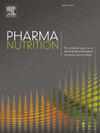Enhanced absorption of omega-3 fatty acids from a novel krill oil-derived phospholipid formulation compared to fish oil ethyl esters: A randomized, two-way crossover pharmacokinetic study
IF 2.4
Q3 NUTRITION & DIETETICS
引用次数: 0
Abstract
Background
Eicosapentaenoic acid (EPA) and docosahexaenoic acid (DHA) offer many health benefits, yet the absorption from standard ethyl ester (EE) formulation requires concurrent intake of a fatty meal. This study aimed to evaluate the absorption of EPA and DHA from a novel omega-3 formulation, Phospholipids + EPA/DHA (PL+), which combines high phospholipdi krill oil (KO) and EE, in comparison to a standard EE product under a low-fat dietary condition in healthy adults.
Methods
In this randomized, cross-over, single-dose study, the pharmacokinetic profiles of EPA and DHA from PL+ and EE product was assessed. Each products contained approximately 1200 mg EPA+DHA. Participants consumed a single dose of the capsules under a low-fat diet regimen, with plasma samples collected at baseline and over a 72-hour period after dosing. Following a 14-day washout period, participants crossed over to the alternate treatment. Plasma concentrations of EPA, DHA, and combined EPA+DHA were analyzed.
Results
Twelve participants (six women and six men) were included, completed all study visits and were included in the analyses. The participants' mean age was 34.3 years (SD = 12.4), and the mean BMI was 22.6 kg/m² (SD = 3.2). The baseline-corrected incremental area under the curve (iAUC0–12h) for combined EPA+DHA was significantly higher for PL+ (255.5 [SD = 81.4] μg/mL*h) compared to EE (34.2 [SD = 33.4] μg/mL*h; P < 0.001). The treatment ratio of iAUC0–12h for PL+ relative to EE was 10.5 (95 % CI: 6.1 – 18.1; P < 0.001). Similar patterns were observed for iAUC0–24h and iAUC0–72h for combined EPA+DHA, as well as for EPA and DHA individually. Sensitivity analyses by adjusting the minimal difference on dose between products yielded consistent findings.
Conclusions
The results indicate that PL+ technology significantly enhances the absorption of EPA and DHA compared to standard EE alone in a low-fat dietary condition. These outcomes suggest that the absorption of EE formulations can be significantly improved through combination with high phospholipid krill oil, as evidenced by the performance of the PL+ formulation.
与鱼油乙酯相比,新型磷虾油磷脂配方能促进ω-3脂肪酸的吸收:随机双向交叉药代动力学研究
背景二十碳五烯酸(EPA)和二十二碳六烯酸(DHA)具有许多健康益处,但要从标准乙酯(EE)配方中吸收这两种物质,需要同时摄入脂肪餐。本研究旨在评估健康成年人在低脂饮食条件下,与标准 EE 产品相比,对新型欧米伽-3 配方磷脂 + EPA/DHA (PL+) 中 EPA 和 DHA 的吸收情况,该配方结合了高磷脂磷虾油 (KO) 和 EE。每种产品都含有约 1200 毫克 EPA+DHA。参与者在低脂饮食方案下服用单剂量胶囊,并在基线和服药后 72 小时内采集血浆样本。经过 14 天的冲洗期后,参与者换用另一种疗法。结果有 12 名参与者(6 名女性和 6 名男性)完成了所有研究访问并被纳入分析。参与者的平均年龄为 34.3 岁(SD = 12.4),平均体重指数为 22.6 kg/m²(SD = 3.2)。与 EE(34.2 [SD = 33.4] μg/mL*h;P <0.001)相比,PL+(255.5 [SD = 81.4] μg/mL*h)的 EPA+DHA 组合基线校正增量曲线下面积(iAUC0-12h)明显更高。相对于 EE,PL+ 的 iAUC0-12h 治疗比为 10.5(95 % CI:6.1 - 18.1;P <;0.001)。对于 EPA+DHA 组合以及单独的 EPA 和 DHA,iAUC0-24h 和 iAUC0-72h 也观察到类似的模式。结果表明,在低脂饮食条件下,与单独使用标准 EE 相比,PL+ 技术能显著提高 EPA 和 DHA 的吸收。这些结果表明,通过与高磷脂磷虾油的结合,EE 配方的吸收可以得到明显改善,PL+ 配方的表现就是证明。
本文章由计算机程序翻译,如有差异,请以英文原文为准。
求助全文
约1分钟内获得全文
求助全文
来源期刊

PharmaNutrition
Agricultural and Biological Sciences-Food Science
CiteScore
5.70
自引率
3.10%
发文量
33
审稿时长
12 days
 求助内容:
求助内容: 应助结果提醒方式:
应助结果提醒方式:


